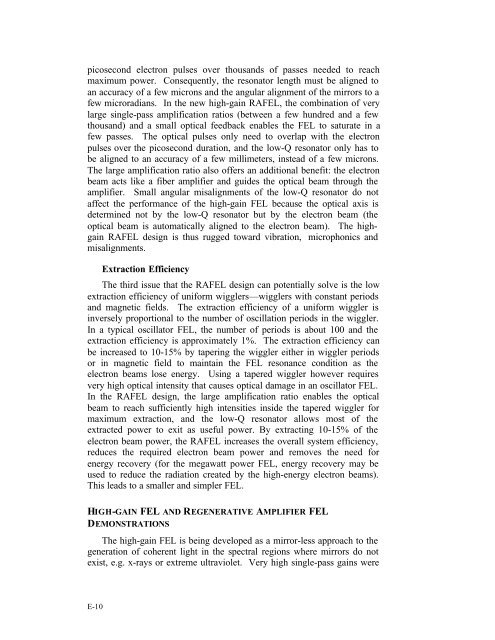High Energy Laser Weapons Systems Applications - The Black Vault
High Energy Laser Weapons Systems Applications - The Black Vault
High Energy Laser Weapons Systems Applications - The Black Vault
Create successful ePaper yourself
Turn your PDF publications into a flip-book with our unique Google optimized e-Paper software.
picosecond electron pulses over thousands of passes needed to reach<br />
maximum power. Consequently, the resonator length must be aligned to<br />
an accuracy of a few microns and the angular alignment of the mirrors to a<br />
few microradians. In the new high-gain RAFEL, the combination of very<br />
large single-pass amplification ratios (between a few hundred and a few<br />
thousand) and a small optical feedback enables the FEL to saturate in a<br />
few passes. <strong>The</strong> optical pulses only need to overlap with the electron<br />
pulses over the picosecond duration, and the low-Q resonator only has to<br />
be aligned to an accuracy of a few millimeters, instead of a few microns.<br />
<strong>The</strong> large amplification ratio also offers an additional benefit: the electron<br />
beam acts like a fiber amplifier and guides the optical beam through the<br />
amplifier. Small angular misalignments of the low-Q resonator do not<br />
affect the performance of the high-gain FEL because the optical axis is<br />
determined not by the low-Q resonator but by the electron beam (the<br />
optical beam is automatically aligned to the electron beam). <strong>The</strong> highgain<br />
RAFEL design is thus rugged toward vibration, microphonics and<br />
misalignments.<br />
Extraction Efficiency<br />
<strong>The</strong> third issue that the RAFEL design can potentially solve is the low<br />
extraction efficiency of uniform wigglers—wigglers with constant periods<br />
and magnetic fields. <strong>The</strong> extraction efficiency of a uniform wiggler is<br />
inversely proportional to the number of oscillation periods in the wiggler.<br />
In a typical oscillator FEL, the number of periods is about 100 and the<br />
extraction efficiency is approximately 1%. <strong>The</strong> extraction efficiency can<br />
be increased to 10-15% by tapering the wiggler either in wiggler periods<br />
or in magnetic field to maintain the FEL resonance condition as the<br />
electron beams lose energy. Using a tapered wiggler however requires<br />
very high optical intensity that causes optical damage in an oscillator FEL.<br />
In the RAFEL design, the large amplification ratio enables the optical<br />
beam to reach sufficiently high intensities inside the tapered wiggler for<br />
maximum extraction, and the low-Q resonator allows most of the<br />
extracted power to exit as useful power. By extracting 10-15% of the<br />
electron beam power, the RAFEL increases the overall system efficiency,<br />
reduces the required electron beam power and removes the need for<br />
energy recovery (for the megawatt power FEL, energy recovery may be<br />
used to reduce the radiation created by the high-energy electron beams).<br />
This leads to a smaller and simpler FEL.<br />
HIGH-GAIN FEL AND REGENERATIVE AMPLIFIER FEL<br />
DEMONSTRATIONS<br />
<strong>The</strong> high-gain FEL is being developed as a mirror-less approach to the<br />
generation of coherent light in the spectral regions where mirrors do not<br />
exist, e.g. x-rays or extreme ultraviolet. Very high single-pass gains were<br />
E-10





![Combat Support in Korea [270 Pages] - The Black Vault](https://img.yumpu.com/49796461/1/190x71/combat-support-in-korea-270-pages-the-black-vault.jpg?quality=85)











